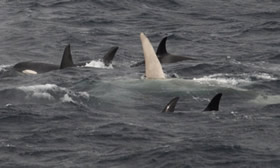Scientists spy mythic white orca in the Aleutians
March 6, 2008
Courtesy of Far North Science
By Doug O'Harra Fisheries biologists cruising the remote Aleutian Islands on a pollock survey caught sight of one of the North Pacific's rarest creatures: a white orca.

Thar He Blows! The white whale was a type of orca that eats only fish. Credit: H. Fearnbach/NMML NMFS permit 782-1719
Rather than sporting the species’ iconic black-and-white markings, the animal swimming with its fish-eating pod two miles off Kanaga Volcano exhibited almost no visible pigment, according to scientists with the National Marine Fisheries Service.
Seeing the animal’s off-white dorsal fin breaking through the roiling waves as it cavorted with its family group made for an extraordinary moment.
“With hundreds of killer whales documented around the Aleutian Islands, this was equivalent to finding a needle in a haystack,” said Holly Fearnbach, a research biologist who was able to photograph the whale’s white fin and back.
The scientists were aboard the NOAA research vessel Oscar Dyson, conducting assessments of pollock fish stocks near haul-outs of the endangered Steller sea lion. About two miles off Kanaga Volcano, on Feb. 23, the white orca swam into view with its pod.
NOAA Fisheries offered more details in an on-line story:

Credit: H. Fearnbach/NMML NMFS permit 782-1719
The white whale is a fish-eating type of killer whale, as were all the killer whales photographed on the expedition. Fish-eating killer whales are the most frequently seen whales around the Aleutian Islands during the summer. The winter sightings represent important evidence that they may be common year-round.
“Despite the typical stormy weather that makes research operations very difficult in the winter, the scientific team on Oscar Dyson has been pulling in a huge amount of planned research data,” said Alaska Fisheries Science Center director Doug DeMaster. “Extraordinary sightings like this white whale are icing on the cake.”
Few white killer whales have ever been seen, according to Fearnbach, much less scientifically documented.
This whale is likely not a true albino because it still has signs of darker pigmented areas on its body. However, because of its prominent coloring, the white whale serves as an indicator for movements of killer whales in the North Pacific.
Other sightings of a white killer whale have been reported previously in the Aleutian Islands as well as in the Bering Sea and off the Russian coast. Scientists are working to confirm whether or not the individual whale sighted Feb. 23 has been reported earlier.
Besides fish and marine mammal researchers from the Alaska Fisheries Science Center, /Oscar Dyson/ also carried a bird observer from the US Fish and Wildlife Service. All added to scientific knowledge about the marine ecosystem of the Aleutian Islands in winter.
 Most of Far North Science is written and edited by Doug O'Harra, a writer and journalist based in Anchorage, Alaska.
Most of Far North Science is written and edited by Doug O'Harra, a writer and journalist based in Anchorage, Alaska. |


